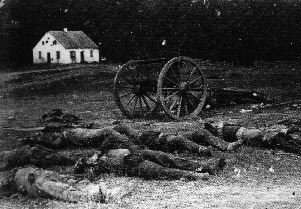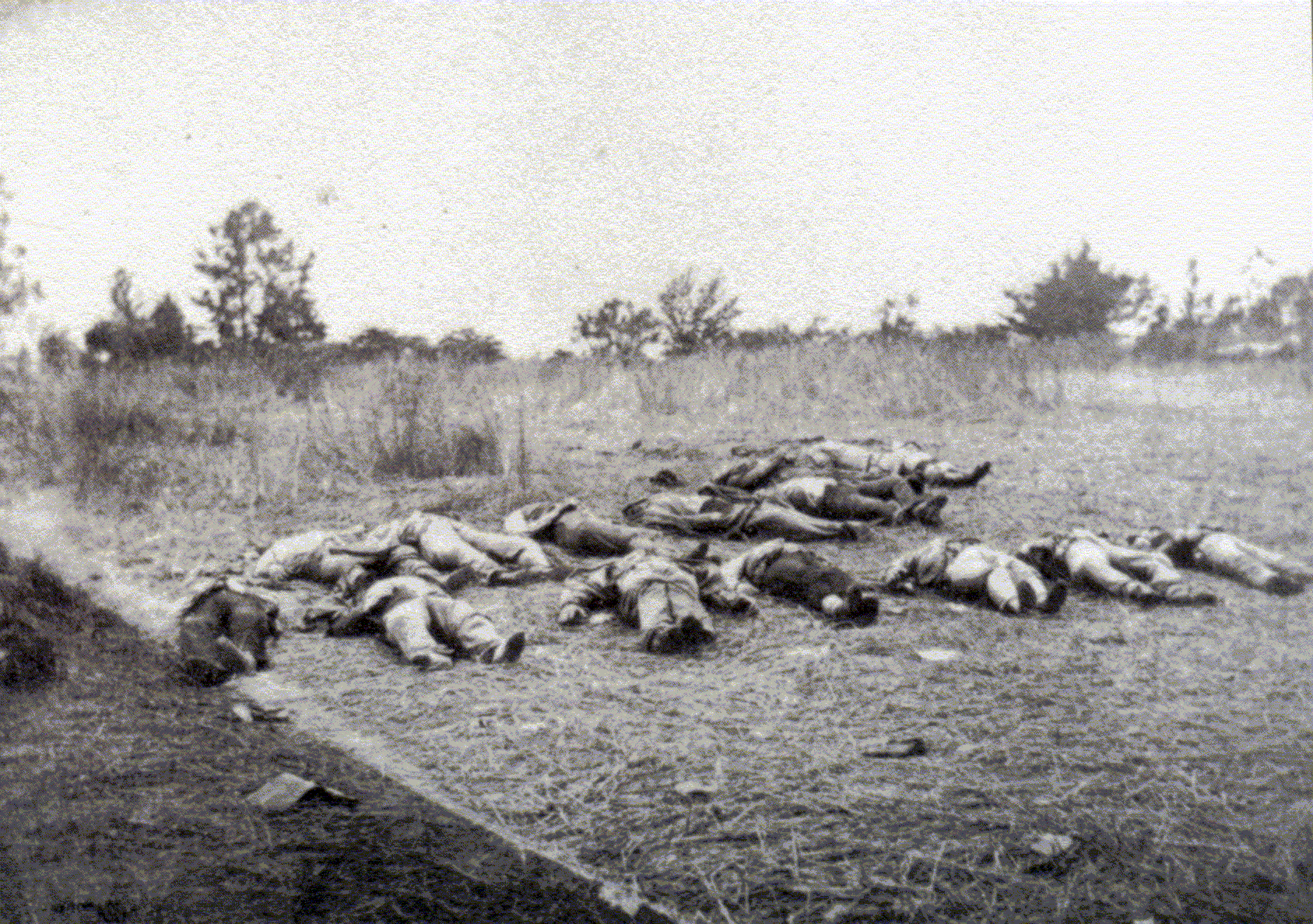|
3rd Arkansas Volunteer Infantry Regiment
The Third Arkansas Volunteer Infantry Regiment was composed of eleven companies organized from Ashley, Drew, Union, Hot Spring, and Dallas Counties,
in southern Arkansas in the Spring
of 1861.
. The regiment was expanded to an over strength organization when a
Company (L) of Arkansas, commanded by Captain Joseph D. Christian of Ashely
county, joined Rust’s command in Virginia on August 14, 1861. All companies, except Company H, were composed wholly by Arkansans. Company H was comprised
of men from Kentucky and Arkansas.
The first official muster of the Regiment was held on June 9, 1861.
Shortly thereafter, ten companies left Arkansas for the seat of the war in Virginia. The companies left at varying times.
The ten companies reached their rendezvous point at Lynchburg,
Virginia, by early July. On July 3 and 4, company and regimental officers were "officially"
appointed and elected. Albert Rust from Union County was elected Colonel, Seth Maxwell Barton Barton, a Virginian was assigned by the Confederate war Department
to the Arkansas Regiment as Lieutenant Colonel and Vannoy Hartrog "Van" Manning of Ashley County was elected Major.
On July 5 the Regiment was mustered into Confederate Service "for the war, “ the first Arkansas
regiment to do so. The Company Captains elected were: Co.
A, William H. Tebbs; Co. B, James H. Capers; Co. C, Thomas M. Whittington; Co.
D, Captain Robert S. Taylor; Co. E., Thomas F. Nolan; Co. F, Daniel A. Newman;
Co. G, John W. Reedy; Co. H, Samuel V. Reid; and Co.
I George D. Alexander. The regiment was expanded to an over strength organization
when a Company (L) of Arkansas, commanded by Captain Joseph D. Christian of
Ashely county, joined Rust’s command in Virginia on August 14, 1861. All companies, except Company H, were composed entirely of Arkansans. Company
H was comprised of men from Kentucky and Arkansas.
During the next four years the Third Arkansas
would participate in six campaigns, nine battles, five major engagements, five
sieges, and a long list of military operations and skirmishes. The Third Arkansas
gained a reputation as gritty, tenacious fighters, and always seemed to end up in some of the most hotly-contested parts of
the battlefield—the Sunken Road at Sharpsburg—the
Devil’s Den at Gettysburg—and consequently suffered a high casualty
rate. During its four years of war 1,353 men served in the Third Arkansas.
Only 150 remained at the surrender.
In January of 1862, five new companies of the Arkansas troops arrived
in Virginia. These troops, known as the 2nd Battalion, Arkansas Infantry,
were commanded by major Wm. N. Bronaugh. This Battalion saw much fighting during the Peninsula Campaign of 1862 ands suffered
very heavy casualties at the battles of Seven Pines (May 31-June 1), Beaver Dam Creek or Mechanicsville (June 26) and at Gaines’
Mill on June 27. On July 18, 1862, the 133 survivors of the 2nd
Battalion, Arkansas Infantry, were assigned to and amalgamated with the 3rd Arkansas Infantry Regiment.
On March 4, 1862, Colonel Rust was appointed a brigadier-general
in the Provisional Army of the Confederate States. Major Manning succeeded him as colonel, and commanded the Third Arkansas
until he was severely wounded and captured at the Battle of Wilderness, May 6, 1864.
In the first year of the war, the Arkansans were constantly reassigned to different
brigades and divisions throughout Virginia and North
Carolina. The Regiment participated in the ill-fated
Campaign in West Virginia during the Fall of 1861 and Stonewall Jackson’s disastrous march on Romney West Virginia in
the winter of 1861-1862. In early Spring of 1862 the Arkansas troops traveled
to the North Carolina coastal area to counter a Federal invasion attempt. In
late May, Rust’s Regiment moved back to Virginia and occupied a position
near Drewry’s Bluff on the James River south of Richmond
. The 3rd Arkansas mostly marched and counter Marched during the
Seven Day’s Battles. They missed Second Manassas. The regiment finally
saw heavy action at the bloody lane at Sharpsburg,
September 17, 1862. When
the sunken road fell to the Federals the 27th North Carolina joined
the 3rd Arkansas in a hopeless counterattack. The two regiments struck with such force that the Federals halted their attack on the center. This attack saved General Lee’s Army.

|
| Confederate Dead Near the Ducker Church |
At the battle of Sharpsburg, Companies A and L were decimated. On September 25, 1862 the few survivors of Company L were transferred into Company A and Company L ceased
to exist. Thus the regiment was reduced to ten companies, the normal complement for an infantry regiment.
The Army of Northern Virginia was reorganized during November 1862. The War Department wanted to have regiments from
the same states brigaded together. The 3rd Arkansas Infantry was the only "Razorback" Regiment in Virginia.
Fortunately, however, there were only three Texas Regiments under Lee’s command as a perfect combination was worked
out involving the two contiguous frontier states. The 3rd Arkansas
was transferred into Hood’s Texas Brigade. The Texans and Arkansas
remained brigaded together until the final curtain at Appomattox.
The Texas Brigade saw limited action at Fredericksburg. In February of 1863 the brigade was assigned to the Department of North Carolina and Southern
Virginia. The brigade siege of Suffolk, Virginia
and several other minor engagements. The
brigade missed the battle of Chancellorsville. When they
were reunited with the Army of Northern Virginia before the Gettysburg Campaign the men were spoiling for a fight.
At Gettysburg, the 1st Texas,
3rd Arkansas, and elements of Benning's Brigade fought through the Rose woods
and triangle field and took Devil's Den late in the day from Brigadier General Hobart Ward's Federal brigade. They held the ground until the retreat of the Army of Northern Virginia.
The regiment suffered heavy casualties.
After Gettysburg,
Longstreet’s Corps was sent west to join the Army of Tennessee. At the
battle of Chickamauga, Georgia, on September
19 and 20, 1863, the regiment was part of the Confederate force that broke the Federal line on the second day of fighting
and helped to rout the Union Army of the Cumberland.
Following Chickamauga
the Arkansans participated in the siege of Chattanooga. Longstreet’s Corps was ordered to Knoxville Tennessee
prior to Grant’s breaking the siege at Chattanooga. The brigade took part in the siege of Knoxville.
In late April of 1864 Longstreet’s Corps
was ordered to return to the Army of Northern Virginia. At the Battle
of the Wilderness, the Arkansans once acquitted themselves admirably, by plugging a gap torn in the Confederate line at the
battle at critical moment. In the Wilderness,
the Third Arkansas experienced some of their most serious losses, including their gallant Colonel Van Manning. Severely
wounded and captured, he sat out the rest of the war as a prisoner. Major William K. Wilkins (who had succeeded Major John
W. Reedy, killed in action at Chickamauga) was killed at the Wilderness. Lieutenant-Colonel
Robert Samuel Taylor, was severely wounded at the Wilderness, but recovered and commanded the Third Arkansas when the Army
of Northern Virginia surrendered at Appomattox Court House on April 9, 1865.
The Arkansans participated in the overland campaign of 1864 and the siege of Petersburg. With the fall of Petersburg, the Arkansans
joined the Army of Northern Virginia in the last retreat. The Arkansans surrendered
at Appomattox. During its four years
of war 1,353 men served in the Third Arkansas. Only 150 remained at the surrender. The
paroles of the Third Arkansas troops were finally signed on April 12, and they were released to go home.

|
| Confederate Dead in the Rose Woods at Gettysburg |
Battle Honors
of the Third Arkansas Infantry
Operations
on Cheat Mountain, West Virginia,
September 11-17, 1861.
March on Romney,
West Virginia, November 26, 1861 to
February 21, 1862.
Battle
of Seven Pines, Virginia, May 31 to June
1, 1862.
Siege, Harper’s Ferry, West Virginia,
September 13, 1862.
Battle
of Sharpsburg, Maryland, September 17, 1862.
Bolivar Heights,
West Virginia, September 19, 1862.
Operations in Loudoun, Fauquier and Rappahannock Counties, Virginia,
October 26 to November 10, 1862.
Fredericksburg,
Virginia, December 12-15, 1862.
Siege
at Suffolk, Virginia,
April 11 to May 4, 1863.
Battle
of Gettysburg, Pennsylvania,
July 1-3, 1863.
Battle
of Chickamauga, Georgia,
September 19-21, 1863.
Siege of Chattanooga, Tennessee,
September 24 to November 1, 1863.
Knoxville
Campaign, Tennessee, November 4 to December
23, 1863.
Siege, Knoxville, Tennessee,
November 17 to December 4, 1863.
Assault, Forts Saunders and
Loudoun, Knoxville, Tennessee, November 29, 1863.
Operations about Dandridge,
Tennessee, January 16 to January 17, 1864.
Operations about Dandridge, Tennessee,
January 26-28, 1864.
Wilderness, Virginia,
May 5-7, 1864.
Assault of the Salient, Spotsylvania
Court House, Virginia, May 12, 1864.
Operations on the line of the North Anna River, Virginia, May 22-26, 1864.
Operations on the line of the Pamunkey River,
Virginia, May 26-28, 1864.
Operations on the line of the Totopotomoy
River, Virginia, May 28-31, 1864.
Cold
Harbor, Virginia, June 1-12,
1864.
Assault, Petersburg, Virginia,
June 15, 1864.
Siege operations against Petersburg
and Richmond, Virginia, June 16, 1864 to April 2, 1865.
Assault,
Petersburg, Virginia, June 18, 1864.
Engagements at Deep Bottom, New Market
Road and Darbytown Road, Virginia,
August 13-20, 1864.
Engagement, Fair Oaks
and Darbytown Road, Virginia,
October 27-28, 1864.
Appomattox
Campaign, March 28 to April 9, 1865.
Assault and capture,
Petersburg Lines, Virginia, April 2, 1865.
Surrender, Appomattox
Court House, Virginia, April 9, 1865.
|

